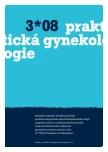Particular characteristics of anorexia nervosa in adolescent girls
Authors:
R. Vavrušová
Authors‘ workplace:
CDOZS Poliklinika akad. O. Teyschla Brno
Published in:
Prakt Gyn 2008; 12(3): 172-179
Overview
Anorexia nervosa is a psychosomatic disorder whose principal symptom is permanent active refusal of food and a dramatic loss of weight. Body weight is kept at least 15 % under the level of the normal body weight. Anorexia nervosa most typically develops in puberty between the age of 12 and 18, in 0.5–1 % of population. Girls are affected more often than boys and make 90 – 95 % of cases. Menstru ation cycle disorders develop as a result of rapid loss of weight by 15 %, or of body fat below 22 %. Loss of menstru ation is not considered as a consequence of cachexia only, but as the primary symptom of the disease. Low estrogen level over a longer period of time is a risk factor for the development of osteoporosis. The gynaecologist is often the first medical specialist visited by the patient. Typically, the principal reason for the visit is a menstru ation cycle disorder manifested by hypo - oligomenorrhea or amenorrhea. The treatment of anorectic patients is difficult and prolonged. It involves renutrition, hormone substitution therapy and psychotherapy. Timely and correct multidisciplinary care may help the affected person’s social adaptation, which is the principal prerequisite of successful treatment.
Key words:
anorexia nervosa – amenorrhea – BMI – hormone substitution therapy
Sources
1. Broulík P. Osteoporóza a její léčba. Praha: Maxdorf 2007 : 19 – 23.
2. Cibula D, Henzl M, Živný J et al. Základy gynekologické endokrinologie. Praha: Grada 2002 : 119 – 135.
3. DeCherney AH, Nathan L. Current obstetric & gynecologic diagnosis & treatment. New York: The McGraw - Hill Companies 1991 : 151 – 154.
4. Frankel GJ, Halmi KA. An adolescent with anorexia nervosa and gastro intestinal stroma tumors. Am J Psychiatry 2003; 160(6): 112 – 114.
5. Geržová H. Současný pohled na hormonální antikoncepci u adolescentek. Gynekolog 2007; 14(4): 156 – 160.
6. Golden NH, Iglesias EA, Jacobson MS et al. Alendronate for the treatment of osteopenia in anorexia nervosa: a randomized, double - blind, placebo - controlled trial. J Clin Endocrinol Metab 2005 : 60 – 65.
7. Hanyášová T. Semestrální projekt – Mentální anorexie na základních školách. 2006. http:/ / terez.ic.cz/ index.php?akce=statistika.
8. Hořejší J. Dětská gynekologie. Praha: Avicenum 1990 : 141 – 150.
9. Hrodek O, Vavřinec J et al. Pediatrie. Praha: Galén 2002 : 157 – 163.
10. Hynková M, Hynek K. Menstru ační cyklus a jeho poruchy u dívek. Mod Gyn Por 2001; 10(4): 419 – 423.
11. Kramulová D. Jídlo jako vášeň. Psychologie dnes 2007; 13(12): 29 – 32.
12. Krch FD. Poruchy příjmu potravy. Praha: Grada 2005 : 39 – 42.
13. Lebl J, Provazník K, Hejcmanová L. Preklinická pediatrie. Praha: Galén 2003 : 178 – 179.
14. Madhusmita M et al. Role of Cortisol in Menstru al Recovery in Adolescent Girls with Anorexia Nervosa. International Pediatrics Research Foundation 2006.
15. Makalová D, Hořejší J. Antikoncepce pro mladistvé. Mod Gyn Por 2001; 10(4): 437 – 445.
16. Winston AP, Alwazeer AE, Bankart MJ. Screening for osteoporosis in anorexia nervosa. Prevalence and predictors of reduced bone mineral density. Int J Eat Disord 2008; 41(3): 284 – 287.
Labels
Paediatric gynaecology Gynaecology and obstetrics Reproduction medicineArticle was published in
Practical Gynecology

2008 Issue 3
Most read in this issue
- Chronic vaginal dryness in oncology patients
- Particular characteristics of anorexia nervosa in adolescent girls
- Selektivní antagonista muskarinových M3 receptorů v léčbě hyperaktivního močového měchýře (overactive bladder, OAB) – darifenacin
- Prenatal preventi on of dental caries
